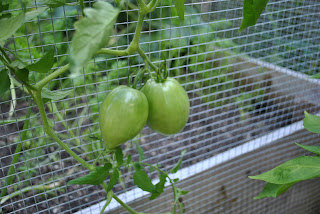Lobelias are going strong, both the cardinal flower (L. cardinalis)

and great blue lobelia (L. siphilitica).

Recently I saw a hummingbird at the cardinal flower, which was the cause of great excitement! I didn't think anything as cool as a hummingbird would come anywhere near the Suburban Wasteland, but lo and behold there was one feasting in my rain garden! Of course there is no photographic evidence; I just stood in shock for about 20 seconds until it flew away. But that was good enough for me! Both of these lobelias prefer wet soil, including periodic flood conditions, and they tolerate partial shade. They're native to swampy prairies and savannas, such as those that flourished here in the northern Illinois clay prior to settlement.
OK, moving on...
Goldenrods are starting to bloom, such as zig-zag goldenrod (Solidago flexicaulis)

and elm-leaved goldenrod (S. ulmifolia),

the latter which grows well in the shade with big-leaved aster (Eurybia macrophylla).

A lazily late-blooming liatris (L. aspera) is mixing its fuzzy purple blooms with tall coreopsis (C. tripteris)

which even by itself is as cheerful as a black-eyed susan or sunflower.

My Joe-Pye weed (Eupatorium maculatum) is well on its way to becoming frilly masses of tannish seeds, but it's still covered in pollinators (enlarge to see the bumblebee)

and other visitors.

The shortgrass prairie still has weeks to go before it settles down for late fall and winter, with grasses and the Plants Formerly Known as Asters still gearing up for their final flowering.
For more wildflowers blooming this Wednesday, see Gail and Clay and Limestone!



















